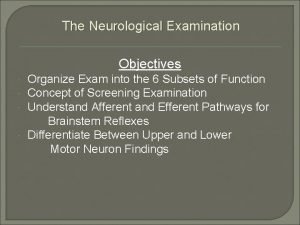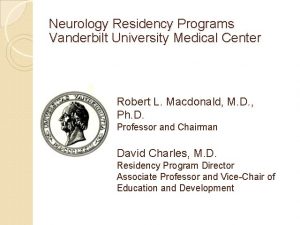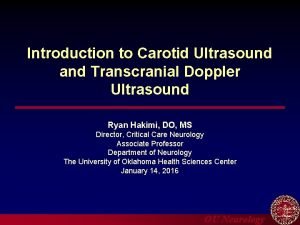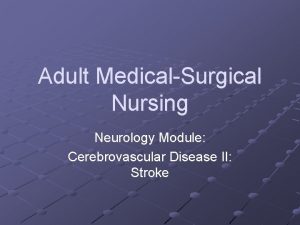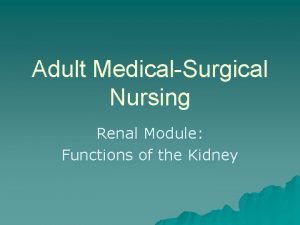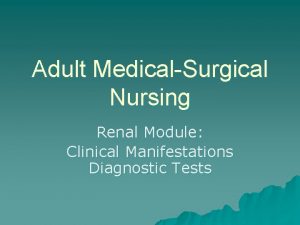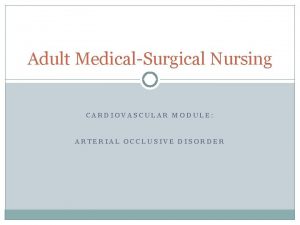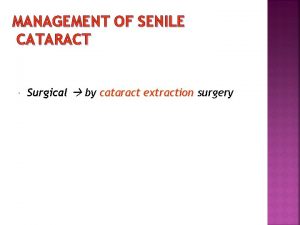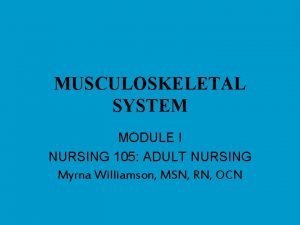Adult MedicalSurgical Nursing Neurology Module Cataract Cataract Description













- Slides: 13

Adult Medical-Surgical Nursing Neurology Module: Cataract

Cataract: Description A cataract is a lens opacity or cloudiness Cataract is a leading cause of blindness worldwide (WHO)

Cataract: Aetiology/ Risk Factors Ageing An associated eye condition (retinal detachment, uveitis, herpes) Toxins: corticosteroids, metals, tobacco Malnutrition: obesity, poor nutrition Physical: trauma, chronic dehydration Systemic disorders: Downs syndrome, DM, renal, musculoskeletal, lipid disorders

Cataract: Pathophysiology May develop in one or both eyes Classification according to location in lens: Nuclear Cortical Posterior sub-capsular Ageing may cause clumping or breakdown of lens protein (yellow pigmentation), ↓ O 2 uptake, ↑ sodium and calcium

Cataract: Classification Nuclear: associated with ↑ myopia Cortical: Anterior, posterior or equatorial cortex of lens Less effect on vision but vision worse in bright sunlight (also areas of high sunlight exposure ↑ prevalence) Posterior sub-capsular: younger people, corticosteroids, trauma, inflammation. Near vision ↓; sensitive to glare

Cataract: Clinical Manifestations Painless, blurred vision Reduced visual acuity Reduced light transmission Sensitivity to glare Colour shift Myopia (short-sightedness) Astigmatism Diploplia

Cataract: Diagnosis History and clinical picture Snellen visual acuity test (visual acuity proportional to lens density) Ophthalmoscopy Slit lamp Above tests establish degree of cataract formation

Cataract: Management No medical treatment Surgery if severe visual problems Most common surgery is extra-capsular cataract extraction with intraocular lens implant (IOL) (posterior chamber lens): Portion of anterior capsule removed to allow extraction of lens nucleus and cortex Posterior capsule and zonal support left intact

Post-Operative Eye Drops/ Ointment Antibiotics Anti-inflammatory Corticosteroids

Cataract Surgery: Complications Haemorrhage (suprachoroidal: profuse) Rupture of posterior capsule Infection: acute and persistent low-grade inflammation/ granuloma Suture-related problems Malposition of IOL (implant) Opacification of posterior capsule Risk of retinal detachment

Cataract: Nursing Considerations Monitor degree of visual impairment Lifestyle aids if necessary Emotional/ psychological support Patient education pre-surgery: Performed under local anaesthetic Anticoagulants with-held Mydriatic eye-drops dilate pupil to prepare for surgery

Cataract: Nursing Considerations (cont) Post-surgery: Verbal and written instructions on eye protection (ensure patient understands) Eye covered with sterile pad for 24 hours until 1 st dressing by surgeon (avoid sleeping on affected side) Dark glasses by day and shield cover at night to prevent self-damage Instructions to family about eye-drops. Arrange district nurse if no carer.

Cataract Surgery: Follow-up Instructions Always wear dark glasses/ eye shield as instructed Wash hands before touching eye/ instilling drops Clean eye with clean tissue: wipe closed eye once from inner to outer canthus Avoid stooping/ climbing stairs/ lifting until instructed Assistance and caution showering
 Postoperative nursing diagnosis for cataract surgery
Postoperative nursing diagnosis for cataract surgery Bsc hons adult nursing
Bsc hons adult nursing Bsc hons adult nursing
Bsc hons adult nursing Dr séra péter
Dr séra péter C device module module 1
C device module module 1 The walton centre for neurology and neurosurgery
The walton centre for neurology and neurosurgery Motor strength scale
Motor strength scale Wake forest neurology residency
Wake forest neurology residency Pmg neurology
Pmg neurology Mary bridge neurology clinic
Mary bridge neurology clinic Difference between doppler and duplex
Difference between doppler and duplex West coast neurology
West coast neurology Surgery nbme percentiles
Surgery nbme percentiles Rrerl
Rrerl






